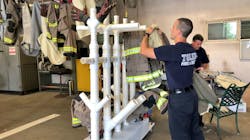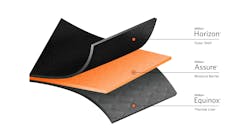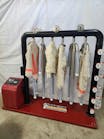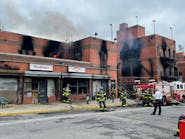OH Firefighter's Design Quickly Dries Clean PPE
By Allison Dunn
Source The Blade, Toledo, Ohio
May 31 -- Clean firefighters’ turnout gear hung to dry from a clothesline in the apparatus bay at Toledo Fire Department Station 9.
Black, soot-covered gear was traditionally thought of as a badge of honor, but health concerns have prompted fire officials to try to change that mindset.
It can take hours, if not days, for the heat-protective gear — including a two-layer coat, gloves, and pants — to dry following a 45-minute heavy-duty wash cycle.
Now, a new piece of equipment — designed by one of Toledo Fire and Rescue Department’s own — aims to cut down the drying time and encourage firefighters to religiously wash their gear, which is often contaminated by carcinogenic toxins from a fire incident. It’s just another piece of the department’s cancer prevention efforts.
It’s a simple, but ingenious idea, firefighters from the South Toledo fire station said, as they hung pieces of gear on the new dryer. It’s built from stacks of PVC pipes — resembling a drying rack — on a rolling box. A floor dryer quietly supplies air through the pipes to dry the gear.
The gear dryer, designed by Pvt. Scott Martin, cuts drying time from several hours to approximately 45 minutes, officials said.
“When I became a firefighter, [I learned] your gear is wet every day. It is sopping wet, it won’t dry,” Private Martin said, who came up with the concept when he was in the fire academy. “This stuff is so thick it just stays wet and stinky.”
Private Martin researched commercial turnout gear dryers, which can cost upward of nearly $9,000. The firefighter, who has a background in carpentry and remodeling, figured he could recreate a similar piece using inexpensive material.
“Anyone could do what I did there. It was a simple idea for a problem,” he said.
When he was assigned to Toledo Fire Station 7, which has been ranked in recent Firehouse Magazine surveys among the busiest departments and apparatus in the country, Private Martin said crew members were always trying to dry their frequently used turnout gear. Their gear laid all over the apparatus bay — on the floor, on ropes, on ladders, with hope it would dry in time before their next run, Private Martin said.
He left the dryer for the crew members at Station 7 as his “parting gift” before he was assigned to Station 6, which is also ranked 34th for busiest station in the nation, according to the Firehouse Magazine survey.
Toledo firefighters already have two sets of turnout gear — yet another part of cancer prevention, thanks to fire administration’s efforts — but there are days when crews are responding to multiple fires in one day, said Toledo Fire Department Safety Officer Lt. Ron Kay.
So firefighters are often forced to choose between “the lesser of two evils,” meaning which set of gear is less dirty or wet, said department spokesman Pvt. Sterling Rahe. But even slightly dirty gear may have already been exposed to toxic fumes and materials, which are often burning plastic and petroleum-based products.
“I want to do everything I can to protect this next generation of firefighters,” Lieutenant Kay said. “All these classes that we’ve hired, these young firefighters, I want to protect them. The only way we’re going to lessen the cancer rate among firefighters is with these preventative efforts right now.”
Firefighters face a 9 percent increase in cancer diagnoses and a 14 percent increase in cancer-related deaths, compared to the general population in the U.S., according to the National Fire Protection Association.
Several studies are being completed to see what specifically is causing such high cancer rates among firefighters, said Battalion Chief Matt Brixey. Firefighters are exposed to hundreds of chemicals during a fire incident, he said.
“We don’t really know what is increasing our risk. Until we get the results, we have to do as much as we can to protect ourselves,” he said.
Private Martin said he didn’t build the dryer for the recognition, he only wanted clean, dry gear.
Officials want the same for all firefighters, so a deputy chief asked Private Martin to build an additional 10 dryers for stations who requested them.
“It’s saving the city a ton of money. It’s really an effective piece of equipment,” Private Rahe said. “It’s going to get used all of the time.”
Additionally, in the next few weeks, the department will be rolling out “After Fire Decontamination Buckets,” which is a bucket including adult wet wipes, a standard garden hose, and scrub brushes, to help clean off a firefighter should he or she be covered in dirt or soot following a fire. It will help with the initial clean up efforts before a firefighter is able to shower.
This too is part of the cancer prevention program.
“Before, we really didn’t have a whole lot of means to clean [firefighters] up,” Lieutenant Kay said. “Everything we get from inside the fire building, we’re taking in the cab of that right and that’s what we’re driving around all day on medical emergency calls. We’re breathing everything in.”
The idea was shared from firefighters in Cincinnati.
___ (c)2018 The Blade (Toledo, Ohio) Visit The Blade (Toledo, Ohio) at www.toledoblade.com Distributed by Tribune Content Agency, LLC.






